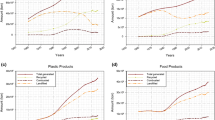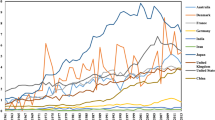Abstract
A supply chain is a system which moves products from a supplier to customers, which plays a very important role in all economic activities. This paper proposes a novel algorithm for a supply chain network design inspired by biological principles of nutrients’ distribution in protoplasmic networks of slime mould Physarum polycephalum. The algorithm handles supply networks where capacity investments and product flows are decision variables, and the networks are required to satisfy product demands. Two features of the slime mould are adopted in our algorithm. The first is the continuity of flux during the iterative process, which is used in real-time updating of the costs associated with the supply links. The second feature is adaptivity. The supply chain can converge to an equilibrium state when costs are changed. Numerical examples are provided to illustrate the practicality and flexibility of the proposed method algorithm.
摘要
创新点
-
1.
基于多头绒泡菌模型在迭代过程中的连续性, 提出了一种新的策略用来解决交通网络中的用户均衡问题;
-
2.
利用用户均衡和系统最优之间的转化关系, 多头绒泡菌模型解决了最优供应链网络设计问题;
-
3.
通过与现有算法相比较, 多头绒泡菌算法不仅找到了最优解, 而且迭代次数更少。
Similar content being viewed by others
References
Liu Z, Nagurney A. Supply chain networks with global outsourcing and quick-response production under demand and cost uncertainty. Annals Oper Res, 2013, 208: 251–289
Zhang W, Xu D. Integrating the logistics network design with order quantity determination under uncertain customer demands. Expert Syst Appl, 2014, 41: 168–175
Yu M, Nagurney A. Competitive food supply chain networks with application to fresh produce. Eur J Oper Res, 2013, 224: 273–282
Hu Z, Du X. Lifetime cost optimization with time-dependent reliability. Eng Optim, 2014, 46: 1389–1410
Ma H, Suo C. A model for designing multiple products logistics networks. Int J Phys Distrib & Log Manag, 2006, 36: 127–135
Zhu X, Yao Q. Logistics system design for biomass-to-bioenergy industry with multiple types of feedstocks. Bioresource Tech, 2011, 102: 10936–10945
Santoso T, Ahmed S, Goetschalckx M, et al. A stochastic programming approach for supply chain network design under uncertainty. Eur J Oper Res, 2005, 167: 96–115
Zhou G, Min H, Gen M. The balanced allocation of customers to multiple distribution centers in the supply chain network: a genetic algorithm approach. Comput Ind Eng, 2002, 43: 251–261
Trkman P, McCormack K. Supply chain risk in turbulent environments–a conceptual model for managing supply chain network risk. Int J Prod Econ, 2009, 119: 247–258
Altiparmak F, Gen M, Lin L, et al. A steady-state genetic algorithm for multi-product supply chain network design. Comput Ind Eng, 2009, 56: 521–537
Ahmadi J A, Azad N. Incorporating location, routing and inventory decisions in supply chain network design. Transport Res Part E: Log Transport Rev, 2010, 46: 582–597
Nagurney A. Supply chain network design under profit maximization and oligopolistic competition. Transport Res Part E: Log Transport Rev, 2010, 46: 281–294
Bilgen B. Application of fuzzy mathematical programming approach to the production allocation and distribution supply chain network problem. Expert Syst Appl, 2010, 37: 4488–4495
Beamon B M. Supply chain design and analysis: models and methods. Int J Prod Econ, 1998, 55: 281–294
Sabri E H, Beamon B M. A multi-objective approach to simultaneous strategic and operational planning in supply chain design. Omega, 2000, 28: 581–598
Handfield R B, Nichols E L. Supply Chain Redesign: Transforming Supply Chains into Integrated Value Systems. Upper Saddle River: FT Press, 2002
Nagurney A. Optimal supply chain network design and redesign at minimal total cost and with demand satisfaction. Int J Prod Econ, 2010, 128: 200–208
Jiang W, Yang Y, Luo Y, et al. Determining basic probability assignment based on the improved similarity measures of generalized fuzzy numbers. Int J Comput Commun Control, 2015, 10: 333–347
Deng Y. Generalized evidence theory. Appl Intell, 2015, 43: 530–543
Deng Y, Mahadevan S, Zhou D. Vulnerability assessment of physical protection systems: a bio-inspired approach. Int J Unconv Comput, 2015, 3–4: 227–243
Jiang W, Luo Y, Qin X, et al. An improved method to rank generalized fuzzy numbers with different left heights and right heights. J Intell Fuzzy Syst, 2015, 28: 2343–2355
Deng X, Hu Y, Deng Y, et al. Supplier selection using AHP methodology extended by D numbers. Expert Syst Appl, 2014, 41: 156–167
Deng Y, Chan F T. A new fuzzy dempster MCDM method and its application in supplier selection. Expert Syst Appl, 2011, 38: 9854–9861
Deng Y, Chan F T, Wu Y, et al. A new linguistic MCDM method based on multiple-criterion data fusion. Expert Syst Appl, 2011, 38: 6985–6993
Stephenson S L, Stempen H, Hall I. Myxomycetes: a Handbook of Slime Molds. Portland: Timber Press, 1994
Nakagaki T, Yamada H, Tóth Á. Intelligence: Maze-solving by an amoeboid organism. Nature, 2000, 407:470
Zhang X, Zhang Z, Zhang Y, et al. Route selection for emergency logistics management: a bio-inspired algorithm. Saf Sci, 2013, 54: 87–91
Zhang X, Zhang Y, Hu Y, et al. An adaptive amoeba algorithm for constrained shortest paths. Expert Syst Appl, 2013, 40: 7607–7616
Zhang X, Wang Q, Chan F T S, et al. A Physarum polycephalum optimization algorithm for the bi-objective shortest path problem. Int J Unconv Comput, 2014, 10: 143–162
Tero A, Kobayashi R, Nakagaki T. Physarum solver: a biologically inspired method of road-network navigation. Phys A, 2006, 363: 115–119
Zhang X, Huang S, Hu Y, et al. Solving 0-1 knapsack problems based on amoeboid organism algorithm. Appl Math Comput, 2013, 219: 9959–9970
Zhang X, Wang Q, Adamatzky A, et al. A biologically inspired optimization algorithm for solving fuzzy shortest path problems with mixed fuzzy arc lengths. J Optimiz Theory Appl, in press. doi: 10.1007/s10957-014-0542-6
Zhang Y, Zhang Z, Deng Y, et al. A biologically inspired solution for fuzzy shortest path problems. Appl Soft Comput, 2013, 13: 2356–2363
Zhang X, Liu Q, Hu Y, et al. An adaptive amoeba algorithm for shortest path tree computation in dynamic graphs. arXiv: 1311.0460. 2013
Gunji YP, Shirakawa T, Niizato T, et al. An adaptive and robust biological network based on the vacant-particle transportation model. J Theor Biol, 2011, 272: 187–200
Shirakawa T, Gunji, Y P. Computation of Voronoi diagram and collision-free path using the plasmodium of physarum polycephalum. Int J Unconv Comput, 2010, 6: 79–88
Shirakawa T, Gunji Y P. Emergence of morphological order in the network formation of Physarum polycephalum. Biophys Chem, 2007, 128: 253–260
Gao C, Lan X, Zhang X, et al. A bio-inspired methodology of identifying influential nodes in complex networks. PloS one, 2013, 8: e66732
Nakagaki T, Iima M, Ueda T, et al. Minimum-risk path finding by an adaptive amoebal network. Phys Rev Lett, 2007, 99: 068104
Adamatzky A. Route 20, autobahn 7, and slime mold: approximating the longest roads in USA and Germany with slime mold on 3-D terrains. IEEE Trans Cybernetics, 2014, 44: 126–136
Tero A, Yumiki K, Kobayashi R, et al. Flow-network adaptation in Physarum amoebae. Theory Biosci, 2008, 127: 89–94
Jones J, Adamatzky A. Computation of the travelling salesman problem by a shrinking blob. Natural Comput, 2014, 13: 1–16
Tero A, Takagi S, Saigusa T, et al. Rules for biologically inspired adaptive network design. Science, 2010, 327: 439–442
Adamatzky A, Alonso-Sanz R. Rebuilding Iberian motorways with slime mould. Biosyst, 2011, 105: 89–100
Adamatzky A. Bioevaluation of World Transport Networks. Singapore: World Scientific, 2012
Adamatzky A, Martínez G J, Chapa-Vergara S V, et al. Approximating Mexican highways with slime mould. Natural Comput, 2011, 10: 1195–1214
Gao C, Yan C, Zhang Z, et al. An amoeboid algorithm for solving linear transportation problem. Phys A, 2014, 398: 179–186
Adamatzky A, Martinez G J. Bio-imitation of Mexican migration routes to the USA with slime mould on 3D terrains. J Bionic Eng, 2013, 10: 242–250
Adamatzky A. Physarum Machines: Computers from Slime Mould. Singapore: World Scientific, 2010
Adamatzky A, Schubert T. Slime mold microfluidic logic gates. Mater Today, 2014, 17: 86–91
Nagurney A. A system-optimization perspective for supply chain network integration: the horizontal merger case. Transport Res Part E: Log Transport Rev, 2009, 45: 1–15
Nagurney A, Woolley T, Qiang Q. Multi-product supply chain horizontal network integration: models, theory, and computational results. Int Trans Oper Res, 2010, 17: 333–349
Nagurney A. Supply Chain Network Economics: Dynamics of Prices, Flows and Profits. Cheltenham: Edward Elgar Publishing, 2006
Nagurney A, Dong J, Zhang D, et al. A supply chain network equilibrium model. Transport Res Part E: Log Transport Rev, 2002, 38: 281–303
Nagurney A, Woolley T. Environmental and cost synergy in supply chain network integration in mergers and acquisitions. In: Multiple Criteria Decision Making for Sustainable Energy and Transportation Systems. Berlin: Springer, 2010. 57–78
Tero A, Kobayashi R, Nakagaki T. A mathematical model for adaptive transport network in path finding by true slime mold. J Theor Biol, 2007, 244: 553–564
Bell M G, Lida Y. Transportation Network Analysis. Hoboken: John Wiley & Sons, 1997
Si BF, Gao ZY. Modeling Network Flow and System Optimization for Traffic and Transportation System (in Chinese). Beijing: China Communications Press, 2013
Adamatzky A. If BZ medium did spanning trees these would be the same trees as Physarum built. Phys Lett A, 2009, 373: 952–956
Gunji Y P, Shirakawa T, Niizato T, et al. Minimal model of a cell connecting amoebic motion and adaptive transport networks. J Theor Biol, 2008, 253: 659–667
Gunji Y P, Shirakawa T, Niizato T, et al. An adaptive and robust biological network based on the vacant-particle transportation model. J Theor Biol, 2011, 272: 187–200
Tsompanas M A I, Sirakoulis G C. Modeling and hardware implementation of an amoeba-like cellular automaton. Bioinspir Biomim, 2012, 7: 036013
Tsompanas M A I, Sirakoulis G C, Adamatzky A. Evolving transport networks with cellular automata models inspired by slime mould. IEEE Trans Cybern, in press. doi: 10.1109/TCYB.2014.2361731
Kalogeiton V S, Papadopoulos D P, Sirakoulis G C. Hey Physarum! Can you perform SLAM? Int J Unconv Comput, 2014, 10: 271–293
Adamatzky A, Jones J. Road planning with slime mould: if Physarum built motorways it would route M6/M74 through Newcastle. Int J of Bifurcat Chaos, 2010, 20: 3065–3084
Chakravarthy H, Proch P B, Rajan R, et al. Bio inspired approach as a problem solving technique. Netw Complex Syst, 2012, 2: 14–22
Liu Y, Zhang Z, Gao C, et al. A physarum network evolution model based on IBTM. In: Advances in Swarm Intelligence. Berlin: Springer, 2013. 19–26
Author information
Authors and Affiliations
Corresponding author
Rights and permissions
About this article
Cite this article
Zhang, X., Adamatzky, A., Yang, XS. et al. A Physarum-inspired approach to supply chain network design. Sci. China Inf. Sci. 59, 052203 (2016). https://doi.org/10.1007/s11432-015-5417-4
Received:
Accepted:
Published:
DOI: https://doi.org/10.1007/s11432-015-5417-4




